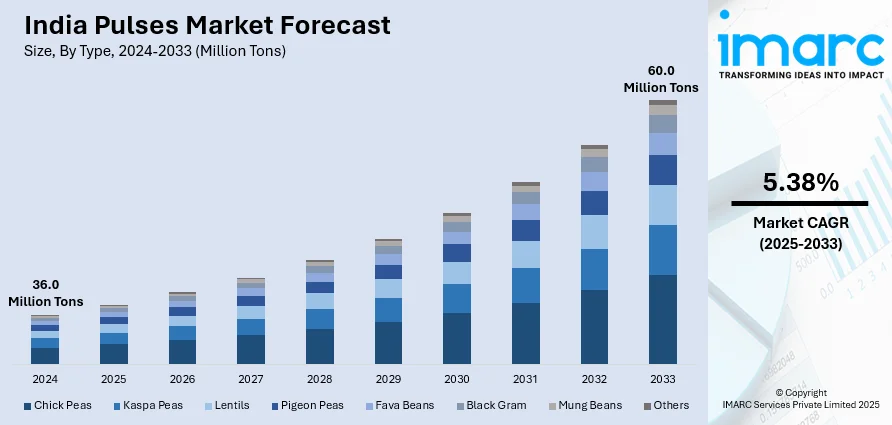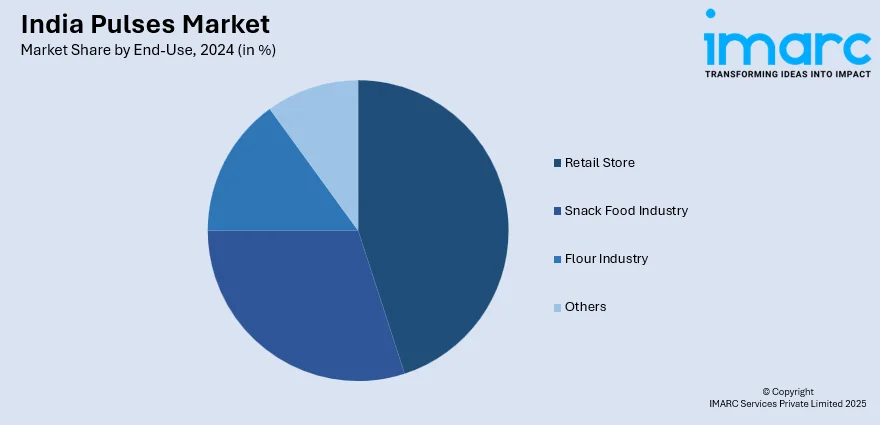
India Pulses Market Size, Share, Trends and Forecast by Type, End-Use, and Region, 2025-2033
Market Overview:
The India pulses market size reached 36.0 Million Tons in 2024. Looking forward, IMARC Group expects the market to reach 60.0 Million Tons by 2033, exhibiting a growth rate (CAGR) of 5.38% during 2025-2033.
|
Report Attribute
|
Key Statistics
|
|---|---|
|
Base Year
|
2024 |
|
Forecast Years
|
2025-2033
|
|
Historical Years
|
2019-2024
|
| Market Size in 2024 | 36.0 Million Tons |
| Market Forecast in 2033 | 60.0 Million Tons |
| Market Growth Rate (2025-2033) | 5.38% |
A significant share of the Indian population are vegetarians and pulses represent the main source of proteins in their diets. Besides proteins, pulses are also a good source of carbohydrates, vitamins, minerals, fatty acids, dietary fibres, etc. Moreover, India’s large consumer base also represents a major driver for the pulses market. From a population of 1.3 Billion in 2018, the Indian population is expected to exceed 1.5 Billion by 2030. This is expected to create a huge demand for food during the period, driving the consumption of pulses in the country. Additionally, apart from being the staple food for people, pulses have found applications in the food processing industry. Pulses flour is considered to be healthier as compared to wheat flour and has been replacing the latter in making snacks and confectionary items to produce healthier food options for health-conscious consumers. Similarly, pulses are also being increasingly used in the ready to eat and snack food industry. As a result of increasing urbanisation and busy lifestyles, healthy ready-to-eat snack foods are becoming increasingly popular with consumers in the country.

To get more information of this market, Request Sample
Key Market Segmentation:
IMARC Group provides an analysis of the key trends in each sub-segment of the India pulses market report, along with forecasts at the country and regional level from 2025-2033. Our report has categorized the market based on type and end-use.
Breakup by Type:
- Chick Peas
- Kaspa Peas
- Lentils
- Pigeon Peas
- Fava Beans
- Black Gram
- Mung Beans
- Others
Breakup by End-Use:

- Retail Store
- Snack Food Industry
- Flour Industry
- Others
Breakup by Region:
- North India
- East India
- West and Central India
- South India
Value Chain Analysis
Key Drivers and Challenges
Porters Five Forces Analysis
PESTEL Analysis
Government Regulations
Competitive Landscape
- Competitive Structure
- Key Player Profiles
Report Coverage:
| Report Features | Details |
|---|---|
| Base Year of the Analysis | 2024 |
| Historical Period | 2019-2024 |
| Forecast Period | 2025-2033 |
| Units | Million Tons, Million USD |
| Segment Coverage | Type, End-Use, Region |
| Region Covered | North India, East India, West and Central India, South India |
| Customization Scope | 10% Free Customization |
| Post-Sale Analyst Support | 10-12 Weeks |
| Delivery Format | PDF and Excel through Email (We can also provide the editable version of the report in PPT/Word format on special request) |
Key Questions Answered in This Report
The India pulses market reached a volume of 36.0 Million Tons in 2024.
We expect the India pulses market to exhibit a CAGR of 5.38% during 2025-2033.
The sudden outbreak of the COVID-19 pandemic has led to the changing consumer inclination from conventional brick-and-mortar distribution channels towards online retail platforms for the purchase of pulses across the nation.
The rising consumer awareness towards the associated benefits of pulses, such as improving digestion, reducing blood glucose, minimizing inflammation, lowering blood cholesterol, etc., is primarily driving the India pulses market.
Based on the type, the India pulses market has been segregated into chick peas, kaspa peas, lentils, pigeon peas, fava beans, black gram, mung beans, and others. Among these, kaspa peas currently hold the largest market share.
Based on the end-use, the India pulses market can be bifurcated into retail store, snack food industry, flour industry, and others. Currently, retail store exhibits a clear dominance in the market.
On a regional level, the market has been classified into North India, East India, West and Central India, and South India, where North India currently dominates the India pulses market.
Need more help?
- Speak to our experienced analysts for insights on the current market scenarios.
- Include additional segments and countries to customize the report as per your requirement.
- Gain an unparalleled competitive advantage in your domain by understanding how to utilize the report and positively impacting your operations and revenue.
- For further assistance, please connect with our analysts.
 Request Customization
Request Customization
 Speak to an Analyst
Speak to an Analyst
 Request Brochure
Request Brochure
 Inquire Before Buying
Inquire Before Buying




.webp)




.webp)












